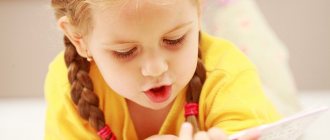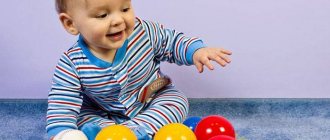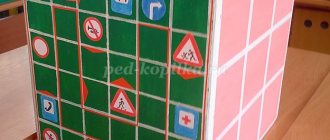Each preschool institution has a certain set of groups that differ not only in the age characteristics of the children, but also in their development, as well as the length of stay. The main groups of a traditional kindergarten are nursery, junior, middle, senior and preparatory. In addition, many kindergartens have speech therapy groups, enrollment in which is carried out at 4-5 years of age, after checking and testing children by a speech therapist. They are divided into groups ONR and FNR. ONR - speech therapy groups in kindergarten, intended for children with general speech impairment, FNR - for children with phonetic, that is, sound, speech impairment. In the summer, general summer groups are usually opened for children attending kindergarten during this period.
Nursery group in kindergarten
The nursery group of the kindergarten accepts the youngest pupils, that is, children who are going to kindergarten for the first time. Their age ranges from one year to two or three years. Such groups are usually located on the ground floor for the convenience of children; the furniture in the group corresponds to their height. Classes on speech development, music, and the environment are conducted in accordance with the plan. Classes are conducted by a teacher in a group and last no more than 10 minutes. Toys must also be age-appropriate - large cubes and pyramids, rubber animals and baby dolls, balls, cars, children's sand play sets, dolls, doll dishes, baby books - all without small and dangerous parts. The daily routine in the nursery group differs from that of older children: early breakfast, lunch, afternoon snack, dinner. Going to bed early for a quiet hour. There should be no more than 10-15 children in such a group. There must always be a nanny present to help dress and undress the babies, feed and wash them, and put them to bed. There is usually only one holiday in the nursery group - New Year, and it is also celebrated in the group.
Educational, developmental and training tasks
The functions of a preschool teacher are varied. Among the main ones I would like to note is ensuring the physical development of children. The teacher must promptly teach children to perform basic movements. Particular attention is paid to the formation of basic cultural and hygienic skills. The middle group of kindergarten assumes a daily routine that harmoniously fits the tasks of developing the cognitive activity of pupils. The work of a teacher involves expanding children's knowledge about people, phenomena and objects. He also teaches how to identify the features of objects through sensory examination, elementary analysis and comparison.
Junior group in kindergarten
The younger group is attended by children aged three to four years. These are more independent children who know and can do a lot. Drawing, physical education and music classes with specialist teachers, drawing and modeling are added to the main classes. The duration of the lesson is 15 minutes. Children at this age love to play role-playing games, so group toys include various but simple children's sets for doctors, hairdressers, builders, cooks, as well as all kinds of construction sets with large parts and figures. Books for reading in a group should already have a long and detailed plot. There should also be books with riddles and simple coloring books with a simple silhouette or outline. In the younger group with children, in addition to celebrating the New Year, there is also a holiday dedicated to March 8th, and they take place in a large common hall. Many children at this age already speak well, so for performances at holidays they can be given poems and small roles to memorize together with their parents.
Math classes
Various activities are organized for all kindergarten students. If we talk about mathematics, it can be noted that in the younger group, educators give children basic knowledge in this area, while the middle group assumes the complication of tasks in the formation of elementary mathematical concepts. Mathematics classes include learning to distinguish the constituent parts of a certain group of objects and the formation of concepts of similarities and differences between them. The teacher develops knowledge that a group of objects is larger than the individual thing that is part of it. Already at this age, children are taught to count to ten.
Middle group in kindergarten
The age of children in the middle group is from four to five years. They are already more physically developed and stronger; they can easily play outdoor games with sports equipment. Therefore, in the middle group of kindergarten it is necessary to conduct as many physical education activities as possible on the street. Classes such as mathematics, literacy, application, and logic are being introduced. Class duration is 20 minutes. You can enroll children in additional clubs - dance, English, arts and crafts, etc. Toys and games include cubes with complex patterns for making pictures, lotto and dominoes, educational board games, as well as glove toys for acting out theatrical scenes and fairy tales. Children can now not only listen to a fairy tale to the end, but also, having memorized the roles, show it to children of younger groups. “Autumn Festival” and “Spring Festival” are added to the main matinees.
Age characteristics of middle group children
Nadezhda Kubatkina
Age characteristics of middle group children
Age characteristics of middle group children
(45 years)
The ages of four to five years are the middle preschool period . He
is a very important stage in a child’s life. This is a period of intensive development and growth of the child’s body. At this stage, the child’s character changes significantly, and cognitive and communication abilities . There are specific age characteristics of children 4–5 years old according to the Federal State Educational Standard , which parents simply need to know so that the development and upbringing of a preschooler is harmonious.
This means that as the child grows older, he will always find a common language with his peers.
The child’s physical capabilities increase : improves
coordination and movements become more and more confident. Wherein
there is a constant need to move. Actively developing
motor skills, in general the average preschooler becomes more dexterous and
fast compared to the younger ones. It should be noted that age
The characteristics of children 4–5 years old are such that physical activity is necessary
dose so that it is not excessive. This is due to the fact that muscles during this period grow, although quickly, but unevenly, so the child gets tired quickly. Therefore, babies need to be given time to rest. As for the pace of physical development, from 4 to 6 years they do not change significantly. On average, a child grows 5–7 cm per year and gains 1.5–2 kg of weight. All organs and systems of the child’s body grow and develop.
Mental development of a child at the age of 4–5 years, various mental processes quickly develop: memory, attention, perception and others.
An important feature is that they become more conscious and voluntary: volitional qualities develop, which will definitely be useful in the future.
5 things you shouldn't feel ashamed about. The type of thinking characteristic of a child now is visual-figurative. This means that most of the children's actions are
practical, experienced nature. Visibility is very important to them. However, as one grows up, thinking becomes generalized and by older preschool age it gradually turns into verbal and logical thinking.
The memory capacity increases significantly: he is already able to remember
a short poem or an assignment from an adult. Are rising
arbitrariness and stability of attention: preschoolers can within
Concentrately engage in any type of activity
for a short time (15–20 minutes) Taking into account the above age characteristics of children 4–5 years old , preschool teachers create
conditions for productive work and harmonious development of the child.
Role of the game:
Gaming remains the main activity for
baby, but it becomes significantly more complicated compared to early
age _ The number of children participating in communication is increasing . Thematic role-playing games appear. The age characteristics of children 4–5 years old are such that they are more inclined to communicate with peers of the same sex. Girls prefer family and everyday themes (mothers and daughters, shops)
.
Boys prefer to play sailors, military men, and knights. At this stage, children begin to organize their first competitions and strive to succeed.
Creative skills :
Middle preschoolers enjoy mastering various types of creative activities. The child likes to do plot modeling and appliqué. One of the main ones is visual activity. The age characteristics of children 4–5 years old according to the Federal State Educational Standard suggest that at this stage the preschooler has already mastered fine motor skills, which allows him to draw in detail and pay more attention to details. Drawing becomes one of the means of creative self-expression.
The average preschooler can compose a short fairy tale or song,
understands what rhymes are and uses them. Vivid imagination and rich
imagination allows you to create entire universes in your head or on a blank sheet of paper, where a child can choose any role for himself.
Speech development:
During the middle preschool period there is
active development of speech abilities . Significantly improved
sound pronunciation, vocabulary is actively growing, reaching approximately two thousand words or more. Speech age characteristics of children 4–5 years old allow them to more clearly express their thoughts and fully communicate with peers. The child is already able to characterize this or that object, describe his emotions, retell a short literary text, answer an adult’s questions. At this stage of development, children master the grammatical structure of the language: they understand and correctly use prepositions, learn to construct complex sentences, and so on.
Coherent speech develops. Communication with peers and adults In middle preschool age, contacts with peers become of paramount importance. If
Previously, the child had enough toys and communication with his parents, then
Now he needs interaction with other children. Observed
increased need for recognition and respect from peers. Communication, as a rule, is closely related to other activities (games, joint work)
. The first friends appear with whom the child communicates most willingly.
Competition and the first leaders begin to emerge in the group of children Communication with peers is, as a rule, situational in nature. Interaction with adults, on the contrary, goes beyond the specific situation and becomes more abstract. The child regards parents as an inexhaustible and authoritative source of new
information, so he asks them a lot of different questions. It is during this period that preschoolers experience a special need for encouragement and are offended by comments and if their efforts go unnoticed. Sometimes adult family members do not notice these age-related characteristics of children 4–5 years old .
Emotional characteristics .
At this age, significant development of the sphere of emotions occurs. This is the time of first sympathies and affections, deeper and more meaningful feelings. A child can understand the mental state of an adult close to him and learns to empathize. Children are very emotional about both praise and comments; they become very sensitive and vulnerable. By the age of 5, the child begins to be interested in
issues of sex and one's gender identity. As already mentioned,
one of the distinctive features of this
age is a vivid fantasy, imagination. It must be borne in mind that this can give rise to a variety of fears. The child may be afraid of a fairy-tale character or imaginary monsters. Parents do not need to worry too much: this is not a problem, but only the age characteristics of children 4–5 years old .
Psychology knows many ways to combat such fears, but it is important to remember that these are just temporary difficulties that will go away over time if parents do not focus on them or use them against the child for educational purposes.
Education for children 4–5 years old
When training, employees of preschool institutions take into account the psychological and age characteristics of children 4–5 years old . According to the program "From birth to school"
currently used, the emphasis is on the formation and comprehensive development of the individual. At the same time, thematic classes are held with children, which explain the rules of behavior in a team, at home and in public places, the basics of safety, speech development, hygiene skills are improved, and so on. At the same time, the educational process is based on the game.
Teachers introduce the child to new concepts and rules through an accessible and attractive type of activity, taking into account age characteristics
children 4–5 years old.
At this age, it is necessary to expand the child’s horizons and his knowledge about the world around him.
Upbringing
Speaking about raising children of this age , you need to remember that
At this stage, the character changes significantly. Crisis of three years
passes safely, and the child becomes much more comfortable
obedient and flexible than before. It is at this time that children need full communication with their parents. The main function of adults now is to explain in as much detail as possible and show by personal example. The child absorbs everything like a sponge, reaching out to new knowledge with the curiosity of a discoverer. Parents must listen carefully to numerous questions and answer them, because in the family children gain their first knowledge about the world around them and their place in it. It is now that it is necessary to lay down moral qualities, to develop kindness, politeness, responsiveness, responsibility, and love of work in a child. At this stage, the child makes his first friends, so it is very important to teach how to communicate with peers: to give in, to defend one’s interests, to share.
The role of preschool institutions
It is worth noting that the best success in education can be achieved in the case of close and trusting cooperation between the family and the preschool institution, since kindergarten staff take into account the age characteristics of children 4–5 years old . Consultation for parents is one way of such interaction. Adult members
families must have at least minimal training in the field
psychology to better understand your child. Another way
characterize the age characteristics of children 4–5 years old – parental
meeting. Here, educators and a child psychologist, together with adult family members, can outline the basic principles of education and discuss all interesting and controversial issues.
Family is the most important
According to practicing child psychologists, the family
plays a vital role in the development of a child’s personality. The relationship between parents is the first thing a growing child sees; this is the standard that he considers the only true one. Therefore, it is very important that the child has a worthy example in the person of adults. Will give birth
We must remember that it is in preschool age that character traits such as kindness, justice, truthfulness develop, and life values and ideals are laid. Therefore, it is so important to take into account the age characteristics of children 4–5 years old . Assistance in the development of individual character traits should also be carried out in accordance with the gender of the preschooler and the roles of adults in the family. So, the mother teaches the child to find a common language, to seek a compromise, affection, care and love emanate from her.
The father is the personification of the order of protection; he is the first teacher of life, who helps to be strong and purposeful. Relationships within the family are the most important factor influencing the upbringing of a child and his entire subsequent life.
.
Senior group in kindergarten
The senior group of the kindergarten is attended by children aged five to six years. Classes are already becoming more intense, in-depth and longer – 25 minutes each. Activities such as the history of the native land and handicraft skills are often introduced. Children can perform simple exercises from sports such as gymnastics, basketball and some others. The toys in the group should be varied and age-appropriate: mosaics, puzzles, three-dimensional construction sets with many details. Children are also taught housekeeping skills. Therefore, among the toys there should be miniature doll gas stoves, cutlery, an ironing board with a toy iron, brooms, dustpans and brooms. You can invite children to care for indoor flowers, aquarium fish, and parrots. “Christmas”, “Defender of the Fatherland Day”, “Easter”, “Victory Day” are added to holidays and matinees.
Speech development
The middle group of kindergarten involves planning the activities of the teacher in such a way as to give children basic knowledge of sounds and syllables, as well as sentences. In stories from personal experience, children are encouraged to use not only direct but also indirect speech. Attention is paid to ensuring that children actively use different types of complex sentences when communicating. The middle group of kindergarten involves developing skills in retelling literary works with simple plots.
Preparatory group in kindergarten
The preparatory group of the kindergarten is attended by children aged six to seven years. For children, this is a very important, last, final stage before entering school. There are many developmental and educational activities: reading and mathematics, native speech and the world around us, music and physical education, manual labor and origami, modeling and drawing. The group often sets up easels and hangers with clothes from various professions for children’s story games. At this age, children are actively learning the rules of etiquette, as well as traffic rules. Matinees and holidays are complex and theatrical, children can even act as presenters. The graduation party at the end of the year is the most important for children and their parents, where graduates show all their abilities and talents.
Activities, games and holidays with children 5-6 years old.
Includes sections:
- Outdoor games in the senior group. (5-6 years)
Showing publications 1-10 of 122419. All sections | Senior group. Senior preschool age. Children 5-6 years old
New
Photo
The best
Photo report on drawing in the senior group on the topic “It’s raining”
Goal: To develop the ability to figuratively reflect impressions of the surrounding life in drawings. Objectives: - consolidate the ability to build a composition of a drawing; - learn to use acquired techniques to convey phenomena in a drawing; - practice drawing with a simple graphite pencil....
A week to reinforce traffic rules in the senior group
Knowledge of traffic rules is essential for a modern child. Now that the number of cars has increased , you cannot go out with your child without knowing the traffic rules. The state is concerned about the increase in child injuries on the roads. Teaching children proper behavior in...
Speech therapy group in kindergarten
Children are recruited into speech therapy groups by a speech therapist based on preliminary testing and thorough screening. The ONR group includes children with general speech disorders, the FNR group includes children with problems in pronouncing certain sounds. Pupils, in addition to the main classes, engage in special exercises with a speech therapist and teacher aimed at improving and improving their speech. In such groups there are usually not many children - 10-12 people. Classes with a speech therapist can be individual or group, and are conducted according to a schedule. All other classes are conducted according to a simplified and facilitated plan, acceptable for children with such defects.
Summer group in kindergarten
A summer group is usually a temporary group for the summer period, which is attended by children of different ages. There are usually no classes in the summer, but only outdoor games, reading books, going to puppet theaters or museums.
In any group of a preschool institution there must be two teachers and one nanny. The day should be organized strictly according to the regime established for each specific age, with games, walks, activities, and entertainment. Each lesson is held no more than 2 times a week.
Author of the article: Alla







